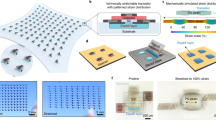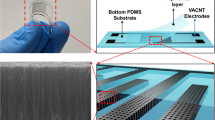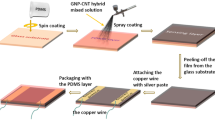Abstract
For the next generation of wearable health monitors, it is essential to develop stretchable and conformable sensors with robust electrical performance. These sensors should, in particular, provide a stable electrical output without being affected by external variables such as induced strain. Here, we report circuit design strategies that can improve the accuracy and robustness of a temperature sensor based on stretchable carbon nanotube transistors. Using static and dynamic differential readout approaches, our circuits suppress strain-dependent errors and achieve a measured inaccuracy of only ±1 oC within a uniaxial strain range of 0–60%. We address device variability by using a one-time, single-point calibration approach. In contrast with previous approaches, which infer temperature change through a normalized measurement at two temperatures, our prototype devices provide an absolute output without temperature cycling. This is essential for practical deployment because heating and cooling the sensor is prohibitively slow and costly during real-time operation and production testing.
This is a preview of subscription content, access via your institution
Access options
Access Nature and 54 other Nature Portfolio journals
Get Nature+, our best-value online-access subscription
$29.99 / 30 days
cancel any time
Subscribe to this journal
Receive 12 digital issues and online access to articles
$119.00 per year
only $9.92 per issue
Buy this article
- Purchase on Springer Link
- Instant access to full article PDF
Prices may be subject to local taxes which are calculated during checkout





Similar content being viewed by others
References
Gao, W. et al. Fully integrated wearable sensor arrays for multiplexed in situ perspiration analysis. Nature 529, 509–514 (2016).
Park, S. I. et al. Soft, stretchable, fully implantable miniaturized optoelectronic systems for wireless optogenetics. Nat. Biotechnol. 33, 1280–1286 (2015).
Chortos, A., Liu, J. & Bao, Z. Pursuing prosthetic electronic skin. Nat. Mater. 15, 937–950 (2016).
Tee, B. C.-K. et al. A skin-inspired organic digital mechanoreceptor. Science 350, 313–316 (2015).
Wehner, M. et al. An integrated design and fabrication strategy for entirely soft, autonomous robots. Nature 536, 451–455 (2016).
Gupta, S. & Loh, K. J. Noncontact electrical permittivity mapping and pH-sensitive films for osseointegrated prosthesis and infection monitoring. IEEE Trans. Med. Imag. 36, 2193–2202 (2017).
Lee, S. et al. A strain-absorbing design for tissue–machine interfaces using a tunable adhesive gel. Nat. Commun. 5, 5898 (2014).
Soekadar, S. R. et al. Hybrid EEG/EOG-based brain/neural hand exoskeleton restores fully independent daily living activities after quadriplegia. Sci. Robot. 1, eaag3296 (2016).
Meijer, G., Pertijs, M. & Makinwa, K. Smart Sensor Systems: Emerging Technologies and Applications (Wiley, New York, NY, 2014).
Hsu, Y.-C. et al. An 18.75 μW dynamic-distributing-bias temperature sensor with 0.87°C (3σ) untrimmed inaccuracy and 0.00946 mm2 area. 2017 IEEE Int. Solid-State Circuits Conf. https://doi.org/10.1109/ISSCC.2017.7870281 (2017).
Yousefzadeh, B., Shalmany, S. H. & Makinwa, K. A. A. A BJT-based temperature-to-digital converter with ±60 mK (3σ) inaccuracy from −55 °C to +125 °C in 0.16-μm CMOS. IEEE J. Solid-State Circuits 52, 1044–1052 (2017).
Deng, C. et al. A CMOS smart temperature sensor with single-point calibration method for clinical use. IEEE Trans. Circuits Syst. II 63, 136–139 (2016).
Ha, D. et al. Time-domain CMOS temperature sensors with dual delay-locked loops for microprocessor thermal monitoring. IEEE Trans. Very Large Scale Integr. Syst. 20, 1590–1601 (2012).
Hattori, Y. et al. Multifunctional skin-like electronics for quantitative, clinical monitoring of cutaneous wound healing. Adv. Healthcare Mater. 3, 1597–1607 (2014).
Jin, H., Abu-Raya, Y. S. & Haick, H. Advanced materials for health monitoring with skin-based wearable devices. Adv. Healthcare Mater. 6, 1700024 (2017).
Yokota, T. et al. Ultra-flexible, large-area, physiological temperature sensors for multipoint measurements. Proc. Natl Acad. Sci. USA 112, 14533–14538 (2015).
Kim, D.-H. et al. Materials for multifunctional balloon catheters with capabilities in cardiac electrophysiological mapping and ablation therapy. Nat. Mater. 10, 316–323 (2011).
Xu, L. et al. 3D multifunctional integumentary membranes for spatiotemporal cardiac measurements and stimulation across the entire epicardium. Nat. Commun. 5, 3329 (2014).
Yan, C., Wang, J. & Lee, P. S. Stretchable graphene thermistor with tunable thermal index. ACS Nano 9, 2130–2137 (2015).
Trung, T. Q., Ramasundaram, S., Hwang, B.-U. & Lee, N.-E. An all-elastomeric transparent and stretchable temperature sensor for body-attachable wearable electronics. Adv. Mater. 28, 502–509 (2016).
Khan, Y., Ostfeld, A. E., Lochner, C. M., Pierre, A. & Arias, A. C. Monitoring of vital signs with flexible and wearable medical devices. Adv. Mater. 28, 4373–4395 (2016).
Webb, R. C. et al. Ultrathin conformal devices for precise and continuous thermal characterization of human skin. Nat. Mater. 12, 938–944 (2013).
Salowitz, N. P. et al. Microfabricated expandable sensor networks for intelligent sensing materials. IEEE Sens. J. 14, 2138–2144 (2014).
Chortos, A. et al. Mechanically durable and highly stretchable transistors employing carbon nanotube semiconductor and electrodes. Adv. Mater. 28, 4441–4448 (2016).
Pochorovski, I. et al. H-bonded supramolecular polymer for the selective dispersion and subsequent release of large-diameter semiconducting single-walled carbon nanotubes. J. Am. Chem. Soc. 137, 4328–4331 (2015).
Lei, T., Pochorovski, I. & Bao, Z. Separation of semiconducting carbon nanotubes for flexible and stretchable electronics using polymer removable method. Acc. Chem. Res. 50, 1096–1104 (2017).
Wang, Y. et al. A highly stretchable, transparent, and conductive polymer. Sci. Adv. 3, e1602076 (2017).
Xu, J. et al. Highly stretchable polymer semiconductor films through the nanoconfinement effect. Science 355, 59–64 (2017).
Li, Y. & Shimizu, H. Toward a stretchable, elastic, and electrically conductive nanocomposite: morphology and properties of poly[styrene-b-(ethylene-co-butylene)-b-styrene]/multiwalled carbon nanotube composites fabricated by high-shear processing. Macromolecules 42, 2587–2593 (2009).
Chortos, A. et al. Investigating limiting factors in stretchable all-carbon transistors for reliable stretchable electronics. ACS Nano 11, 7925–7937 (2017).
Wang, H. & Bao, Z. Conjugated polymer sorting of semiconducting carbon nanotubes and their electronic applications. Nano Today 10, 737–758 (2016).
Zhou, X. J., Park, J. Y., Huang, S. M., Liu, J. & McEuen, P. L. Band structure, phonon scattering, and the performance limit of single-walled carbon nanotube transistors. Phys. Rev. Lett. 95, 146805 (2005).
Gao, J. & Loo, Y.-L. Temperature-dependent electrical transport in polymer-sorted semiconducting carbon nanotube networks. Adv. Funct. Mater. 25, 105–110 (2015).
Yao, Z., Postma, H. W. C., Balents, L. & Dekker, C. Carbon nanotube intramolecular junctions. Nature 402, 273–276 (1999).
Rother, M. et al. Understanding charge transport in mixed networks of semiconducting carbon nanotubes. ACS Appl. Mater. Interfaces 8, 5571–5579 (2016).
Murmann, B. Analysis and Design of Elementary MOS Amplifier Stages (NTS Press, Austin, TX, 2013).
Cai, L., Zhang, S., Miao, J., Yu, Z. & Wang, C. Fully printed stretchable thin-film transistors and integrated logic circuits. ACS Nano 10, 11459–11468 (2016).
Huang, C.-C., Kao, Z.-K. & Liao, Y.-C. Flexible miniaturized nickel oxide thermistor arrays via inkjet printing technology. ACS Appl. Mater. Interfaces 5, 12954–12959 (2013).
Lee, S. W. et al. Positive gate bias stress instability of carbon nanotube thin film transistors. Appl. Phys. Lett. 101, 053504 (2012).
Markenscoff, X. & Yannas, I. V. On the stress–strain relation for skin. J. Biomech. 12, 127–129 (1979).
Acknowledgements
The authors thank M. Claus for helpful discussion on compact model development and F. Lian for the help of collecting SEM images. This work was supported by Samsung Electronics. R.P. acknowledges support from Marie Curie Cofund, Beatriu de Pinós fellowship (AGAUR 2014 BP-A 00094). A.C.H. acknowledges support from the National Science Foundation Graduate Research Fellowship (grant no. DGE-1147474).
Author information
Authors and Affiliations
Contributions
C.Z. and B.M. conceived the concept. C.Z., B.M. and Z.B. conceived the experiments. C.Z., A.C., Y.W. and T.L. developed the fabrication processes. C.Z. and R.P. performed data collection and analysis of temperature-dependence for transistors. A.C.H., C.Z. and J.Y.O. designed the test station with strain and temperature. X.Y. and I.P. synthesized the supramolecular sorting polymer. J.W.-F.T. collected SEM images. Z.B. and B.M. supervised the project. All authors provided comments for the manuscript.
Corresponding authors
Ethics declarations
Competing interests
The authors declare no competing interests.
Additional information
Publisher’s note: Springer Nature remains neutral with regard to jurisdictional claims in published maps and institutional affiliations.
Supplementary information
Supplementary Information
Supplementary Figures 1–11 and Supplementary Table 1
Supplementary Video 1
Demonstration of stretchable temperature sensor attached to the knuckle area of a flexible rubber prosthetic hand
Rights and permissions
About this article
Cite this article
Zhu, C., Chortos, A., Wang, Y. et al. Stretchable temperature-sensing circuits with strain suppression based on carbon nanotube transistors. Nat Electron 1, 183–190 (2018). https://doi.org/10.1038/s41928-018-0041-0
Received:
Accepted:
Published:
Issue Date:
DOI: https://doi.org/10.1038/s41928-018-0041-0
This article is cited by
-
High-speed and large-scale intrinsically stretchable integrated circuits
Nature (2024)
-
A vacuum-deposited polymer dielectric for wafer-scale stretchable electronics
Nature Electronics (2023)
-
Artificial intelligence-powered electronic skin
Nature Machine Intelligence (2023)
-
3D-printed PEDOT:PSS for soft robotics
Nature Reviews Materials (2023)
-
Stretchable graphene–hydrogel interfaces for wearable and implantable bioelectronics
Nature Electronics (2023)



